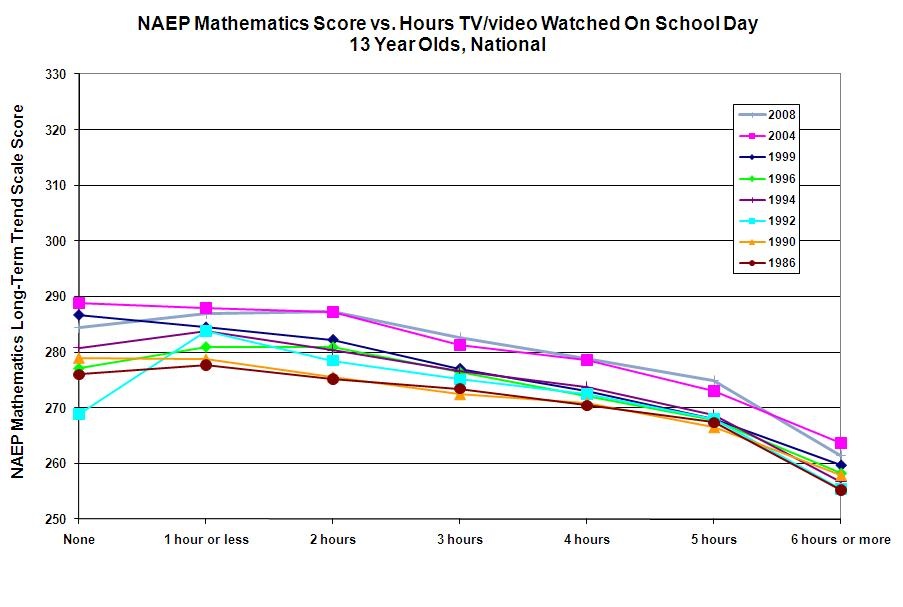What is the relationship between student academic performance and watching TV and video on school nights?
Why is this question important? Students have limited time to divide between activities on school days. Knowing how TV and video watching is generally related to school performance can help them and their parents make informed decisions.
See further discussion below.

Source: National Assessment of Educational Progress Data Explorer
http://nces.ed.gov/nationsreportcard/lttdata/
Results: A correlation between NAEP Math Long-Term Trend Scale Score and TV/video watching 3 hours or more on school nights, with more hours watching corresponding to lower scores. General improvement of scores for all groups from 1986 through 2008.
Implications: Generally less TV and video watching on school nights corresponds with better math scores. It is important to note that causation cannot be inferred from these data.
Authors: National Assessment of Educational Progress, Institute of Education Sciences, National Center for Education Statistics, U.S. Department of Education
Publisher: National Assessment of Educational Progress, Institute of Education Sciences, National Center for Education Statistics, U.S. Department of Education
Study Description: The NAEP long-term math assessment was designed to measure students' 1) knowledge of basic facts, 2) ability to carry out numerical algorithms using paper and pencil, 3) knowledge of basic measurement formulas as they are applied in geometric settings, and 4) ability to apply mathematics to daily-living skills (such as those related to time and money) http://nces.ed.gov/nationsreportcard/ltt/what_measure_mathematics.asp
As part of the NAEP assessment, student questionnaires collect information on students' demographic characteristics, classroom experiences, and educational support. Teacher qustionnaires gather data on teacher background, training, and instructional practices (for grades 4 and 8). School questionnaires, completed by principals or assistant principals, gather information on school policies and characteristics. Questionnaires for Students with disabilities or English language learners (SD/ELL), completed by special education or English language teachers, collect information about students who have disabilities or limited English proficiency. http://nces.ed.gov/nationsreportcard/bgquest.asp
From approximately 27,500 students who took the math assessment, NCES makes a multi-stage sampling of scores, first from representative geographies, then from representative schools, both public and nonpublic, then randomly selecting students within selected schools.http://nces.ed.gov/nationsreportcard/ltt/sampledesign.asp
Results from the long term math assessment were grouped based on how students answered the background question, 'On a school day, about how many hours do you usually watch TV or videotapes outside of school hours?'
Possible answers were: None, 1 hour or less, 2 hours, 3 hours, 4 hours, 5 hours, 6 hours or more, Omitted(no answer).
Definitions:
NAEP = National Assessment of Educational Progress
NCES = National Center for Education Statistics
SD = Students with disabilities
ELL = English Language Learners
National Assessment of Educational Progress Data Explorer Variables:
Subject: Long-Term Trend Mathematics
Measure: Long-Term Trend scale
Age: 13
Jurisdiction: National
Years: 86, 90, 92, 94, 96, 99, 04, 08
Factors Beyond School|Time use outside of school|Amount of TV/video watched on school day
